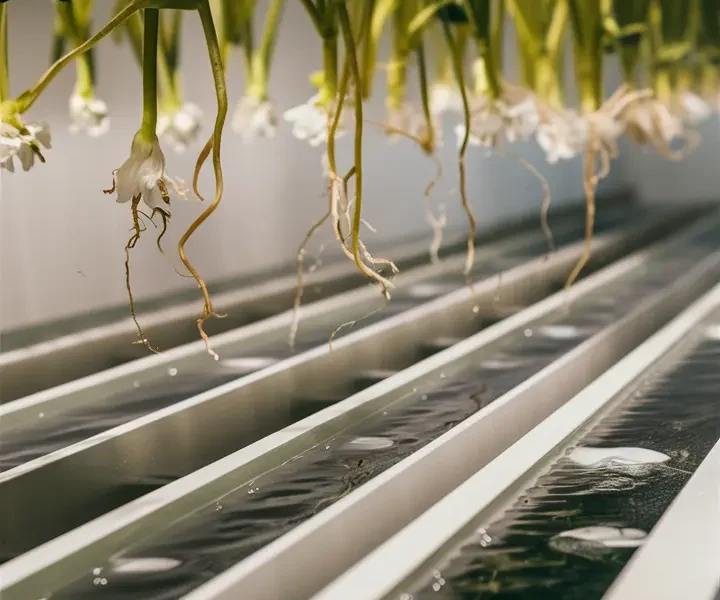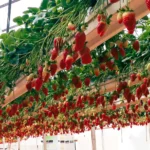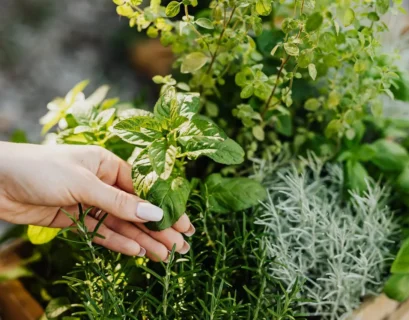Have you ever dreamt of having a bountiful harvest without needing a sprawling garden? Well, dreams can become reality with the magic of hydroponics! It’s a game-changer for urban dwellers and green thumbs alike. In this comprehensive guide, we’ll dive into the world of hydroponic growing system, exploring its benefits, setting up your own system, and mastering the art of cultivating plants without soil.
Table of Contents:
Let’s embark on this exciting journey and unlock the secrets of hydroponic gardening!
What is Hydroponic Growing System?
Hydroponics, simply put, is a method of growing plants without soil. Instead of relying on Mother Earth to provide sustenance, plants are nurtured in a nutrient-rich water solution. Think of it as a plant’s version of a protein shake, providing all the essentials for robust growth.
The term “hydroponics” comes from the Greek words “hydro,” meaning water, and “ponos,” meaning labor. It’s a bit of a misnomer because while it does involve water, hydroponics actually requires more labor and attention than traditional soil gardening.
At the heart of a hydroponics growing system lies a nutrient solution that’s meticulously formulated to mimic the plant’s ideal soil conditions. This solution is usually a mix of water, essential minerals, and sometimes a touch of pH balancer.
But how does it all work? Let’s break it down:
- Root System: The plant’s roots are submerged in the nutrient solution, allowing them to directly absorb essential nutrients.
- Growing Medium: While soil is absent, a growing medium is often used to support the plant’s roots. Think of it as a hydroponic scaffolding. This medium can be anything from inert materials like rockwool or clay pebbles to more organic options like coconut coir or vermiculite.
- Water and Nutrient Delivery: A pump circulates the nutrient solution, ensuring that the roots are constantly bathed in essential elements.
Hydroponics isn’t just a fancy way to grow plants; it’s a science-driven approach that offers a plethora of benefits. But before we dive into the advantages, let’s get a visual glimpse of this fascinating technique.

The image above showcases a simple hydroponic setup. You can see the plant’s roots suspended in a nutrient solution within a container. The pump is responsible for circulating the solution, keeping the roots happy and healthy.
The Benefits of Hydroponic Gardening
Now that you have a basic understanding of what hydroponics is, let’s dive into the exciting world of its advantages! Hydroponic gardening offers a plethora of benefits, making it an increasingly popular choice for home gardeners and commercial growers alike.
Environmentally Friendly
One of the key advantages of hydroponics is its eco-friendliness. Unlike traditional soil-based gardening, hydroponics requires significantly less water. This is because the roots are directly submerged in nutrient-rich water solutions, eliminating the need for large amounts of water to reach the roots through soil. This is a major advantage, especially in areas with water scarcity.
Furthermore, hydroponic systems produce less waste. There’s no need for pesticides or herbicides, as pests and weeds are less likely to infest a controlled environment. This not only promotes healthier food but also reduces the environmental impact of agricultural practices.
Faster Growth and Higher Yields
Hydroponics is known for its faster growth rates and higher yields compared to traditional methods. The controlled environment allows for precise control over nutrient delivery, light exposure, and temperature, maximizing plant growth potential. This means you can enjoy fresh produce sooner and get more from your garden!
For example, let’s say you’re growing tomatoes. A hydroponic system can produce tomatoes up to 50% faster than traditional soil-based methods. Imagine the satisfaction of harvesting a bountiful tomato crop in a shorter time!
Space-Saving and Versatile
Hydroponic gardening is exceptionally space-saving, making it ideal for those with limited outdoor space. You can cultivate a variety of plants vertically or horizontally, utilizing your space more efficiently.
The versatility of hydroponics extends to the types of plants you can grow. From leafy greens and herbs to flowers and even fruits, the possibilities are endless! You can adapt your system to suit your needs and preferences. If you’re interested in exploring different hydroponic systems for growing specific plants, you can find out more here.
Improved Control and Precision
Hydroponics provides unparalleled control and precision over your growing environment. You can customize the nutrient solution, light intensity, and temperature to meet the specific requirements of your plants. This level of control ensures that your plants receive the optimal conditions for healthy growth.
You can even track the progress of your plants and adjust your system accordingly to maximize growth and yield. This is especially beneficial for commercial growers who strive for consistency and efficiency.
Year-Round Gardening
With hydroponics, you can enjoy year-round gardening, regardless of the weather conditions outside. You can cultivate your plants indoors or in a greenhouse, providing a controlled environment where temperatures and light levels remain consistent. This allows you to grow your favorite fruits, vegetables, and herbs throughout the year, ensuring a constant supply of fresh produce.
A Rewarding and Fun Experience
Finally, hydroponics offers a rewarding and fun experience. It’s a great way to learn about plant science, experiment with different techniques, and enjoy the satisfaction of growing your own food. You can get started with a simple system and gradually expand your knowledge and skills as you go along.
Ready to try your hand at hydroponic gardening?
This is just the beginning of your hydroponic journey. As you learn more about the benefits and techniques of this exciting method, you’ll be well on your way to enjoying fresh, homegrown produce all year round.
Setting Up Your Hydroponic Growing System
Ready to dive into the exciting world of hydroponics? Setting up your hydroponics growing system is a rewarding and relatively straightforward process. Here’s a step-by-step guide to help you get started:
- Choose Your Hydroponics System: The first step is selecting the right hydroponics growing system for your needs. There are many options available, each with its own advantages and disadvantages. How to Start a Smart Garden gives a helpful overview of different systems. Consider the space you have available, the type of plants you want to grow, and your budget when making your decision.
- Get the Right Equipment: Once you’ve chosen your system, you’ll need to gather the essential equipment. This typically includes a growing medium, a water reservoir, a pump, a timer, and nutrient solution.
- Prepare Your Growing Medium: Depending on your system, you might need to prepare a growing medium. For example, some hydroponic systems use expanded clay pebbles as the growing medium. These pebbles are inert and help to hold the roots in place while providing good drainage. What are the Best Hydroponic Systems for Growing Flowers is a good resource to learn more.
- Prepare Your Nutrient Solution: A properly formulated nutrient solution is crucial for the success of your hydroponic garden. It provides the plants with all the essential nutrients they need to thrive. There are many different nutrient solutions available, so choose one that is specifically formulated for hydroponics.
- Set Up Your System: Once you’ve gathered your equipment and prepared your nutrient solution, it’s time to set up your hydroponic growing system. Follow the manufacturer’s instructions carefully.
- Plant Your Seeds or Seedlings: Now, it’s time to plant your seeds or seedlings. Be sure to use the right planting medium for your chosen hydroponics growing system. If you are using a wick system, you will want to make sure that the wick is positioned correctly so that it can draw water up to the roots.
- Monitor Your Plants: Once your plants are in place, it’s important to monitor them closely. Make sure that they are getting enough light, water, and nutrients. You may also need to adjust the pH and EC of the nutrient solution as needed.
By following these steps, you can set up your hydroponics growing system and start growing your own delicious and healthy food at home. It can be a bit of a learning curve, but with patience and some research, you’ll be harvesting your own fresh produce in no time!
Essential Nutrients and Growing Conditions
Now that you have your hydroponics growing system set up, it’s time to dive into the crucial elements that make your plants thrive. Just like in soil-based gardening, your plants need a balanced diet of nutrients to flourish.
Essential Nutrients for Hydroponic Growing System
Hydroponic plants need a specific blend of nutrients in their water solution, often referred to as a “nutrient solution” or “hydroponic fertilizer.” These nutrients are divided into two main categories: macronutrients and micronutrients.
Macronutrients are needed in larger quantities and include:
- Nitrogen (N): Crucial for plant growth and leaf development.
- Phosphorus (P): Essential for root development, flower and fruit production, and overall plant health.
- Potassium (K): Plays a role in photosynthesis, disease resistance, and water regulation.
- Calcium (Ca): Necessary for strong cell walls and overall plant structure.
- Magnesium (Mg): Important for chlorophyll production and photosynthesis.
- Sulfur (S): Involved in protein synthesis and enzyme activity.
Micronutrients are needed in smaller quantities, but are just as vital for healthy plant growth:
- Iron (Fe): Essential for chlorophyll production.
- Manganese (Mn): Aids in photosynthesis and enzyme activity.
- Zinc (Zn): Involved in plant hormone production and enzyme activity.
- Copper (Cu): Crucial for photosynthesis and respiration.
- Boron (B): Important for cell wall formation and pollen development.
- Molybdenum (Mo): Necessary for nitrogen fixation.
- Chlorine (Cl): Plays a role in photosynthesis and water regulation.
You can find pre-mixed hydroponic fertilizers or create your own blends using individual nutrient solutions. When choosing your fertilizer, consider the specific needs of your chosen plants.
Pro Tip: Overfeeding or underfeeding your plants can cause problems. Using a hydroponic nutrient solution calculator can help you determine the correct ratios for your specific growing needs.
Optimizing Growing Conditions
Besides nutrients, your hydroponic plants need the right environmental conditions to flourish:
Light: Plants need adequate light for photosynthesis. The amount of light required varies depending on the plant species. Consider using grow lights, especially if you are growing indoors. Learn more about choosing the right grow lights and setting up your lighting system on our blog about how to start a smart garden.
Temperature: Different plants thrive in different temperature ranges. Maintain a comfortable temperature for your chosen plants.
pH: The acidity or alkalinity of the nutrient solution is crucial for plant nutrient uptake. The ideal pH range for most hydroponics systems is between 5.5 and 6.5. Regularly test and adjust the pH as needed.
Oxygen: Your plants need oxygen for respiration. Ensure that your hydroponics growing system provides adequate aeration to the roots.
By providing the right balance of nutrients and optimizing growing conditions, you can encourage your plants to flourish in your hydroponic system. Remember to carefully monitor your plants and adjust your nutrient solution and environment as needed. You’ll be surprised by the bountiful harvest you can achieve using this exciting method of growing!
Popular Hydroponic Techniques and Systems
Now that you have a basic understanding of what hydroponics is and its advantages, let’s delve into some popular techniques and systems that can help you get started. The right system for you depends on your space, budget, and desired yield. Here’s a breakdown of some common approaches:
1. Deep Water Culture (DWC)
DWC, also known as the “bucket system,” is one of the simplest and most widely used hydroponic methods. It involves suspending plants in a nutrient-rich solution contained in a bucket or reservoir. The roots are constantly submerged in the solution, allowing for optimal nutrient uptake. The Click and Grow Smart Garden 9 Review is a popular example of a DWC system that combines ease of use with modern technology.
2. Nutrient Film Technique (NFT)
NFT is a highly efficient method that involves circulating a thin film of nutrient solution over the roots. This constant flow of nutrients ensures that plants receive a consistent supply, leading to faster growth and higher yields. Some systems like the Let Pots 5 Pod vs 12 Pod Hydroponic Growing Systems use NFT for their design.
3. Ebb and Flow (Flood and Drain)
This technique involves periodically flooding the growing medium with nutrient solution before draining it. The ebb and flow allows for better oxygenation of the roots while still providing ample nutrients. Many smart garden systems utilize this method.
4. Aeroponics
Aeroponics is a more advanced and efficient method that involves growing plants with their roots suspended in the air. The roots are sprayed with a fine mist of nutrient solution, providing them with the optimal moisture and nutrients. Aeroponics systems offer excellent control over growth conditions but are more expensive to set up and maintain.
5. Wick System
The Wick system is a passive method that relies on a wick to draw nutrient solution from a reservoir to the plant roots. This method is suitable for beginners as it requires minimal maintenance. However, the wick system may not be as efficient as other techniques, especially for larger plants.
Conclusion:
Hydroponics offers a rewarding and sustainable way to grow your own food, regardless of space or soil limitations. By choosing the right hydroponics growing system, you can enjoy fresh produce all year round. Don’t forget to learn about essential nutrients and maintain optimal growth conditions for your plants.
With some planning and dedication, you’ll be on your way to harvesting delicious homegrown food! If you’re ready to take the plunge into hydroponic gardening, there are many resources available to guide you, including articles on how to start a smart garden. Happy growing!











